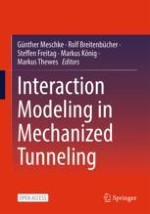Open Access 2023 | Open Access | Buch

Interaction Modeling in Mechanized Tunneling
herausgegeben von: Günther Meschke, Rolf Breitenbücher, Steffen Freitag, Markus König, Markus Thewes
Verlag: Springer Nature Switzerland
Open Access 2023 | Open Access | Buch

herausgegeben von: Günther Meschke, Rolf Breitenbücher, Steffen Freitag, Markus König, Markus Thewes
Verlag: Springer Nature Switzerland
This open access book compiles the research results of the Collaborative Research Center SFB 837, which has been running since 2010 and will end in 2022, with the topic "Interaction Modeling in Mechanized Tunneling". The Collaborative Research Center is funded by the German Research Foundation (DFG) and is currently the world's largest research facility in the field of tunneling. The aim of the publication is to make our scientific findings accessible to the international professional community. The individual chapters deal with all subsystems relevant in mechanized tunneling and their interaction. The latest results of digital planning and real-time tunneling support have been included.